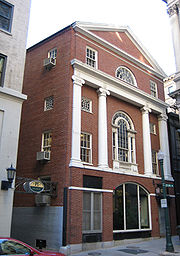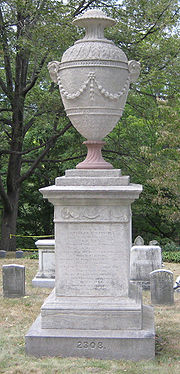
Franklin Place
Encyclopedia

Charles Bulfinch
Charles Bulfinch was an early American architect, and has been regarded by many as the first native-born American to practice architecture as a profession....
and built in Boston, Massachusetts in 1793-95, included a row of sixteen three-story brick townhouses that extended in a 480-foot curve, a small garden, and four double houses. Constructed early in Bulfinch’s career, Franklin Place came after he had seen the possibilities of modern architecture in Europe and had determined to reshape his native city. It was the first important urban housing scheme undertaken in the United States, and the city’s first row-house complex. However, years of decline and the push of industry into the area forced its demolition in 1858.
The Tontine Crescent
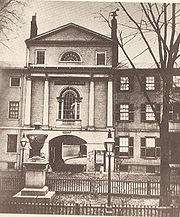
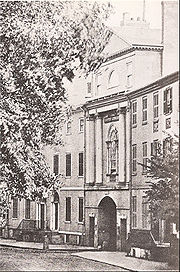
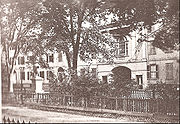

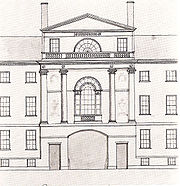
Naples
Naples is a city in Southern Italy, situated on the country's west coast by the Gulf of Naples. Lying between two notable volcanic regions, Mount Vesuvius and the Phlegraean Fields, it is the capital of the region of Campania and of the province of Naples...
banker Lorenzo de Tonti
Lorenzo de Tonti
Lorenzo de Tonti was a governor of Gaeta, Italy and a Neapolitan banker. He invented the tontine, a form of life insurance.Around 1650, he and his wife, Isabelle di Lietto, gave birth to their first son, the future explorer Henri de Tonti...
, which he introduced in France
France
The French Republic , The French Republic , The French Republic , (commonly known as France , is a unitary semi-presidential republic in Western Europe with several overseas territories and islands located on other continents and in the Indian, Pacific, and Atlantic oceans. Metropolitan France...
in the 17th century. Money for the enterprise was to be raised by selling shares of stock to the members of the public, who would later share in the profits from the sale of the homes. It is essentially an annuity, the shares passing on the death of each beneficiary to the surviving partner until all are held by a single shareholder, or being divided among surviving stockholders at the end of a stated period. Although this method of financing was in rather wide use in Europe at the time, the Massachusetts General Court
Massachusetts General Court
The Massachusetts General Court is the state legislature of the Commonwealth of Massachusetts. The name "General Court" is a hold-over from the Colonial Era, when this body also sat in judgment of judicial appeals cases...
refused articles of incorporation and the project ultimately rested on Bulfinch’s meager business talent.
On July 6, 1793, the Columbian Centinel carried the following notice: “The public are hereby informed that a plan is proposed for building a number of convenient, elegant HOUSES, in a central situation, and a scheme of tontine association. The proposals for subscription, and the plans of the Houses, may be seen at the office of Mr. JOHN MARSTON, State-Street.” By the end of the month a sufficient number of subscriptions had been received to warrant the letting of contracts for “the framing, and the door-cases and window-frames of the proposed Tontine Building.” The cornerstone was laid on August 8, and the Crescent was completed the following year.
Building began with less than 50% of the shares taken up and continued in a discouraging atmosphere created by the prolonged negotiations over the Jay Treaty
Jay Treaty
Jay's Treaty, , also known as Jay's Treaty, The British Treaty, and the Treaty of London of 1794, was a treaty between the United States and Great Britain that is credited with averting war,, resolving issues remaining since the Treaty of Paris of 1783, which ended the American Revolution,, and...
. Bulfinch completed the project, including its complementary file of four double houses facing across the grass plot (17-24 Franklin Place), but in so doing sacrificed both his and his wife’s fortunes. As events proved, the Crescent was far too ambitious an idea for either the man or the times, and he and his family were ruined by his determination to finish it at all costs. However, he was gratified “in knowing that not one of my creditors was materially injured, many were secured the full amount, and the deduction on the balance due to workmen did not exceed 10 PC on their entire bills.”
Bulfinch’s first attempt to introduce monumental town planning into Boston, the Crescent was an interesting failure, unlike any other building in America. In fact, not even London
London
London is the capital city of :England and the :United Kingdom, the largest metropolitan area in the United Kingdom, and the largest urban zone in the European Union by most measures. Located on the River Thames, London has been a major settlement for two millennia, its history going back to its...
had a crescent at the time; the architect relied for his model primarily on examples he had seen in Bath—a memory reinforced by a folio of Bath pictures preserved in his library. The Crescent no doubt also owed something to the well-known plan Robert Adam
Robert Adam
Robert Adam was a Scottish neoclassical architect, interior designer and furniture designer. He was the son of William Adam , Scotland's foremost architect of the time, and trained under him...
devised for two half circles of connecting houses as an extension of London’s Portland Place
Portland Place
Portland Place is a street in the Marylebone district of central London, England.-History and topography:The street was laid out by the brothers Robert and James Adam for the Duke of Portland in the late 18th century and originally ran north from the gardens of a detached mansion called Foley House...
, as well as certain examples Bulfinch had seen in Paris
Paris
Paris is the capital and largest city in France, situated on the river Seine, in northern France, at the heart of the Île-de-France region...
. In architectural detail, the Crescent recalls the Adelphi Terrace
Adelphi, London
Adelphi is a district of London, England in the City of Westminster. The small district includes the streets of Adelphi Terrace, Robert Street and John Adam Street.-Adelphi Buildings:...
, which Bulfinch knew both as a center of Neoclassical building in London and as the haunt of exiled Tory relatives and family friends. (Adelphi too was a financial disaster, and the Adam brothers saved their project only through a lottery and the sale of their art collections; Bulfinch lacked such resources.)
This innovative project for a new and fashionable residential district south of the central business district was located in an undeveloped, unpromising bit of fields and marshlands between Milk Street
Milk Street
Milk Street is a street in the financial district of Boston, Massachusetts.Milk Street was one of Boston's earliest highways. The name "Milk Street" was given to the street in 1708 due to the milk market at the location...
and Summer Street that consisted in part of a quagmire that Joseph Barrell
Joseph Barrell (merchant)
Joseph Barrell was a merchant in Boston, Massachusetts in the 18th century. During the American Revolution he owned ships commissioned as privateers, such as the Vengeance, ca.1779. In 1792 Barrell was "elected to the board" of Massachusetts branch of the newly established Bank of the United...
—Bulfinch’s former employer, who had a house on Summer Street—had partially drained and converted into a fish pond in his garden. Its western edge intersected today’s Hawley Street
Hawley Street (Boston)
Hawley Street is located in the Financial District of Boston, Massachusetts, between Milk and Summer Streets. Prior to 1799, it was called Bishop's Alley and briefly in the 1790s Board Alley.-17th century:...
, and on the east it ended near Federal Street. Until the American Revolution
American Revolution
The American Revolution was the political upheaval during the last half of the 18th century in which thirteen colonies in North America joined together to break free from the British Empire, combining to become the United States of America...
, Boston still had enough space in most locations to accommodate single dwellings with small gardens. However, as land values began to rise, many newer dwellings began to be built with their narrow ends to the street and their entrances on the side. With his long row of attached houses, Bulfinch gambled that wealthy individuals would not mind living in relatively cramped quarters. Knowing that most wealthy Londoners living in garden squares also had country estates, he believed perhaps that potential residents of Franklin Place would also have summer homes with large gardens elsewhere.
Thomas Pemberton described the Crescent at the time of completion as “a range of sixteen well built and handsome dwelling houses, extending four hundred and eighty feet in length…The general appearance is simple and uniform.” As Bulfinch’s elevation shows, the chief feature was a central pavilion, slightly higher than the Crescent’s wings, with a large arch that spanned a passageway passing entirely through the structure, an attic story and two secondary pavilions projecting 6’ forward from the middle section. The form was suggested by Queen’s Square in Bath, constructed more than half a century earlier by John Wood, the Elder
John Wood, the Elder
John Wood, the Elder, , was an English architect. Born in Twerton England, a village near Bath, now a suburb, he went to school in Bath. He came back to Bath after working in Yorkshire, and it is believed, in London, in his early 20s...
; the arch, with Palladian window, was probably taken from the Market in High Street, Bristol
Bristol
Bristol is a city, unitary authority area and ceremonial county in South West England, with an estimated population of 433,100 for the unitary authority in 2009, and a surrounding Larger Urban Zone with an estimated 1,070,000 residents in 2007...
, traditionally attributed to Wood also. However, in style the Tontine Crescent was Neoclassical
Neoclassical architecture
Neoclassical architecture was an architectural style produced by the neoclassical movement that began in the mid-18th century, manifested both in its details as a reaction against the Rococo style of naturalistic ornament, and in its architectural formulas as an outgrowth of some classicizing...
rather than Neo-Palladian
Palladian architecture
Palladian architecture is a European style of architecture derived from the designs of the Venetian architect Andrea Palladio . The term "Palladian" normally refers to buildings in a style inspired by Palladio's own work; that which is recognised as Palladian architecture today is an evolution of...
, and its main architectural distinction, three ranges of pilasters rising two stories above an architectural basement, is taken from the Adelphi. Moreover, the structure contained all the Neoclassical elements of the new Federal style
Federal architecture
Federal-style architecture is the name for the classicizing architecture built in the United States between c. 1780 and 1830, and particularly from 1785 to 1815. This style shares its name with its era, the Federal Period. The name Federal style is also used in association with furniture design...
: attenuated pilasters on the central pavilion and two end pavilions that projected forward several feet, swag panels, and delicate fanlight
Fanlight
A fanlight is a window, semicircular or semi-elliptical in shape, with glazing bars or tracery sets radiating out like an open fan, It is placed over another window or a doorway. and is sometimes hinged to a transom. The bars in the fixed glazed window spread out in the manner a sunburst...
s and lunettes. The plan, which featured two large rooms (about 18’ x 18’) on each floor offset by a hallway with main and service staircases, was traditional with London row-house builders since the 17th century. Indeed, the Neoclassical façade of the Adam brothers’ Royal Society of Arts
Royal Society of Arts
The Royal Society for the encouragement of Arts, Manufacturers and Commerce is a British multi-disciplinary institution, based in London. The name Royal Society of Arts is frequently used for brevity...
building in London was another inspiration for the central building. The houses’ brick exterior walls were painted gray to simulate masonry and the architectural detail, apparently all of wood, was painted white. Delicate decorative devices were present on the handsome three-floor houses, each 27’ wide, but ornament was so restrained that there were no frames around the windows. The identical doorways were spaced two to a porch. Each floor consisted of two large rooms, described by Massachusetts Magazine as “spacious and lofty”, with a hallway on one side containing both the main and service stairways.
Once finished, the Crescent received unanimous praise from contemporaries. Asher Benjamin claimed it “gave the first impulse to good taste; and to architecture, in this part of the country.” Massachusetts Magazine called the style “the most improved of modern elegance” and was especially impressed by the spacious rooms and the attention given to household conveniences: “Each house will have annexed to it a pump, rain water cistern, wood house, and a stable, and a back avenue will communicate to all the stables.” Bulfinch was also praised for presenting the large room behind the Palladian window above the arch to the Boston Library Society and the attic above to the newly-founded Massachusetts Historical Society, which at the time was lodged in the northwest corner of Faneuil Hall
Faneuil Hall
Faneuil Hall , located near the waterfront and today's Government Center, in Boston, Massachusetts, has been a marketplace and a meeting hall since 1742. It was the site of several speeches by Samuel Adams, James Otis, and others encouraging independence from Great Britain, and is now part of...
’s attic. (Granted, Bulfinch and his partners did realize it might be difficult to find buyers for the two pavilion rooms, potentially unsuitable for residences.) The Library Society remained there until the building’s demolition in 1858, when the city paid it $12,000 for its room, while the Historical Society stayed until 1833, moving next to the King's Chapel
King's Chapel
King's Chapel is "an independent Christian unitarian congregation affiliated with the Unitarian Universalist Association" that is "unitarian Christian in theology, Anglican in worship, and congregational in governance." It is housed in what was formerly called "Stone Chapel", an 18th century...
burying ground because of cramping and fear of fire.
17-24 Franklin Place


As the site plan made for the Historic American Buildings Survey shows, the axis of the Crescent and the double houses opposite was along the line of Arch Street with the Franklin Urn serving as a focus. The four double houses were of the same architectural proportions, although the middle pair was somewhat larger in area. The end houses were placed obliquely to the middle ones and thus corresponded to the east and west pavilions of the Crescent; the slight angle helped keep the street openings as wide as possible. The houses on both sides of the street had identical fanlight entrance doors, and despite Pemberton’s prediction of variety in architectural treatment, the double houses were quite similar to the opposing Crescent. The major stylistic differences were Bulfinch’s exclusive use of swag panels in the Crescent and recessed brick arches in the houses across the way. No floor plan has been discovered but it is presumed the double houses had the traditional arrangement of two rooms on either side of a transverse hallway divided, as in the Crescent, by main and service staircases. The two center units were much larger than the pairs at the ends and included tiny fenced-in front gardens. The row faced south on the enclosed grass plot and was considered at the time the most modern and pleasant range of houses in Boston.
Other characteristics
Between the Crescent and the double houses was a wrought-iron-fenced semi-oval grass plot 40’ wide at its center and about 280’ long, with shade trees; it was at the heart of the city’s first garden square. In 1795, Bulfinch placed a large Neoclassical urn (similar to one executed by Robert Adam) and pedestal in the square’s center; he had purchased these in Bath and brought them home from his Grand TourGrand Tour
The Grand Tour was the traditional trip of Europe undertaken by mainly upper-class European young men of means. The custom flourished from about 1660 until the advent of large-scale rail transit in the 1840s, and was associated with a standard itinerary. It served as an educational rite of passage...
of 1785-87. Soon after 1858, the urn, which served as a memorial to the late Benjamin Franklin
Benjamin Franklin
Dr. Benjamin Franklin was one of the Founding Fathers of the United States. A noted polymath, Franklin was a leading author, printer, political theorist, politician, postmaster, scientist, musician, inventor, satirist, civic activist, statesman, and diplomat...
, was moved together with the pedestal to Bulfinch’s grave in Mount Auburn Cemetery
Mount Auburn Cemetery
Mount Auburn Cemetery was founded in 1831 as "America's first garden cemetery", or the first "rural cemetery", with classical monuments set in a rolling landscaped terrain...
. While much smaller than its London counterparts, the garden was important for recreation, and its shape echoed that of the surrounding buildings. Also unlike in London, where gated streets allowed entry only to residents, access to the garden was not restricted and it could be enjoyed by visitors to the Library and Historical Societies, as well as by theater- and church-goers. As Massachusetts Magazine observed in 1794, the garden “will contribute to the ornament of the buildings, and be useful in promoting a change and circulation of air.”
Also as part of the complex were included Boston Theater
Federal Street Theatre
The Federal Street Theatre , also known as the Boston Theatre, was located at the corner of Federal and Franklin streets in Boston, Massachusetts. It was "the first building erected purposely for theatrical entertainments in the town of Boston."-History:The original building was designed by Charles...
(1793), the first theater built in Boston, placed at the northeast end of the square, and Holy Cross Church
Holy Cross Church, Boston
The Church of the Holy Cross , located on Franklin Street in Boston, Massachusetts and designed by Charles Bulfinch, was the first church built for the city's Roman Catholics....
(begun 1800), the city’s first Roman Catholic
Roman Catholic Church
The Catholic Church, also known as the Roman Catholic Church, is the world's largest Christian church, with over a billion members. Led by the Pope, it defines its mission as spreading the gospel of Jesus Christ, administering the sacraments and exercising charity...
church, directly opposite the theater at the southeast end. These additional amenities for residents recalled what St Albans
Henry Jermyn, 1st Earl of St Albans
Henry Jermyn, 1st Earl of Saint Albans KG was an English politician and courtier. He sat in the in the House of Commons at various times between 1625 and 1643 when he was raised to the peerage as Baron Jermyn...
had done for St. James's Square
St. James's Square
St. James's Square is the only square in the exclusive St James's district of the City of Westminster. It has predominantly Georgian and neo-Georgian architecture and a private garden in the centre...
, and were a bold move, considering that Puritan Boston had banned theatrical performances until December 1793 and had displayed religious intolerance throughout its history.
What the social life in Franklin Place was like is suggested by two paintings, now held by the Museum of Fine Arts
Museum of Fine Arts, Boston
The Museum of Fine Arts in Boston, Massachusetts, is one of the largest museums in the United States, attracting over one million visitors a year. It contains over 450,000 works of art, making it one of the most comprehensive collections in the Americas...
: Henry Sargent
Henry Sargent
Henry Sargent , American painter and military man, was born in Gloucester, Massachusetts. He was one of seven children born to Daniel and Mary Sargent...
’s The Dinner Party (ca. 1821) and The Tea Party (ca. 1824). These probably represent actual parties that took place in Sargent’s home at 10 Franklin Place, on the Crescent. Based on Bulfinch’s plan, the two rooms depicted in The Tea Party must have been adjoining parlors, most likely on the second floor above the first-floor dining room. The graceful archway connecting the two rooms in the picture is a Neoclassical architectural detail used by Bulfinch to relate the interior of the house to the Palladian window on the Crescent’s central building. Despite the rooms’ long, narrow configuration, lavish entertainment could still take place, in part because the high ceilings made the rooms seem larger. Bulfinch’s drawing of the Crescent suggests that the first- and second-floor windows were of the same height; this is consistent with the interiors shown in the painting and contrasts with London terraces of the period, where the second-floor parlor windows were usually taller. The furnishings that Sargent depicts represent contemporary high-style Boston interiors, in most respects similar to what could be found in London. The dining room in The Dinner Party is quite masculine, with mahogany furniture and large portraits suitable to the gathering of gentlemen, the two parlors or drawing rooms shown in The Tea Party are lighter in feeling, more feminine, and ornamented with many French and Italian decorative objects. The women are adorned with the latest and most expensive fashions of the day—column-like Empire gowns with accompanying shawls.
Demolition and legacy

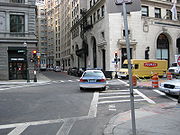

John Murray (minister)
John Murray though sometimes recalled as founder of the Universalist denomination in the United States, might more fairly be described as a pioneer minister and an inspirational figure, as his theological legacy to the later Universalist denomination was minimal.-Early life:He was born in Alton,...
and Judith Sargent Murray
Judith Sargent Murray
Judith Sargent Murray was an early American advocate for women's rights, an essayist, playwright, poet, and letter writer. She was one of the first American proponents of the idea of the equality of the sexes—that women, like men, had the capability of intellectual accomplishment and should be...
, Abby May
Abby May
Abigail "Abby" Alcott was the wife of Transcendentalist Amos Bronson Alcott and mother of four daughters, including Civil War novelist Louisa May Alcott...
, James Perkins, merchant and principal donor to the Boston Athenaeum’s first building, William Tudor, Jr., founder of Monthly Anthology and the North American Review, and his literary associate Dr. John S. J. Gardiner, rector of Trinity Church. Two women owned houses: Abigail Howard, a founder of the Boston Library Society, and Elizabeth Amory. While wealthy merchants and prominent men of letters inhabited both the Crescent and the houses across the street, it was the free-standing houses that became the most fashionable, even though they were more expensive and the side yards were very narrow; Bostonians had a deep-seated preference for even the narrow yards of semi-detached houses as opposed to the block of connected houses, two walls in each of which had to be windowless. The pattern held true in the late 19th and early 20th centuries: except for a few houses in the Back Bay
Back Bay, Boston, Massachusetts
Back Bay is an officially recognized neighborhood of Boston, Massachusetts famous for its rows of Victorian brownstone homes, which are considered one of the best-preserved examples of 19th-century urban design in the United States, as well as numerous architecturally significant individual...
, Bostonians at every class level utterly rejected the connected town house block and instead turned back to some version of the 18th- and early 19th-century ideal of the garden lot and free-standing town house.
Shortly after the Crescent’s completion, the newly-widened Arch Street was extended through the center archway, and other connecting streets were opened to the south and east. The addition of these new streets reflected the growth of the downtown business area immediately surrounding the complex; this long-lasting push by businesses into the area would eventually doom Bulfinch’s buildings. After about thirty years, when the Mount Vernon Proprietors
Mount Vernon Proprietors
Mount Vernon Proprietors is a real estate firm located in Boston, Massachusetts. Founded at the end of the 18th century, it developed land on the south slope of Beacon Hill into a desirable residential neighborhood.-History:...
were developing an exclusive residential neighborhood on Mount Vernon just to the west of Beacon Hill that was beginning to lure affluent residents farther from the central business district, middle-class residents began to move in. The single-family dwellings were soon converted into boarding houses. The new residents were less concerned with the neighborhood’s overall appearance, as seen from late photographs that show the garden overcrowded with small shrubs planted randomly among the trees, and a wood picket fence replacing the original iron posts and chains. Oliver Wendell Holmes, Sr.
Oliver Wendell Holmes, Sr.
Oliver Wendell Holmes, Sr. was an American physician, professor, lecturer, and author. Regarded by his peers as one of the best writers of the 19th century, he is considered a member of the Fireside Poets. His most famous prose works are the "Breakfast-Table" series, which began with The Autocrat...
noted these changes in The Autocrat of the Breakfast-Table, published in 1858 just as demolition was underway: “There were the shrubs and flowers in the Franklin-Place front-yards or borders; Commerce is just putting his granite foot upon them.”

Great Boston Fire of 1872
The Great Boston Fire of 1872 was Boston's largest urban fire, and still ranks as one of the most costly fire-related property losses in American history. The conflagration began at 7:20 p.m. on November 9, 1872, in the basement of a commercial warehouse at 83—87 Summer Street in Boston,...
. The graceful curve and unusual width of Franklin Street today below Hawley Street are reflections of the Crescent’s ground plan. Architectural descendants include the Sears Crescent near today’s Boston City Hall
Boston City Hall
Boston City Hall is the seat of the municipal government of Boston, Massachusetts. Architecturally, it is an example of the brutalist style. It was designed by Kallmann McKinnell & Knowles...
and the façade of the Kirstein Business Branch of the Boston Public Library (built 1929-30), which replicates the entire central portion of the Tontine. Despite residents’ general aversion to connected structures, hundreds of brick row houses in the area draw inspiration from the Bulfinch structure, including Worcester and Chester Squares in the South End; West Hill Place and Charles River Square on Beacon Hill; a set of fifteen attached brick and half-timbered town houses on Elm Hill Avenue in Roxbury
Roxbury, Massachusetts
Roxbury is a dissolved municipality and current neighborhood of Boston, Massachusetts, United States. It was one of the first towns founded in the Massachusetts Bay Colony in 1630, and became a city in 1846 until annexed to Boston on January 5, 1868...
Highlands originally called Harris Wood Crescent; and a block of fifteen red-brick connected houses on Beacon Street in Brookline
Brookline, Massachusetts
Brookline is a town in Norfolk County, Massachusetts, United States, which borders on the cities of Boston and Newton. As of the 2010 census, the population of the town was 58,732.-Etymology:...
, built in 1907.
An economic downturn meant that subscriptions came too slowly to meet bills, and Bulfinch went bankrupt in January 1796, turning from a comfortable situation as a gentleman concerned with architecture to a laborious life of architectural practice and public service. Financial troubles continued to plague him, such that he spent July 1811 in debtors’ prison, but the Crescent and Franklin Place helped transform Boston from an 18th-century town into a 19th-century city.
